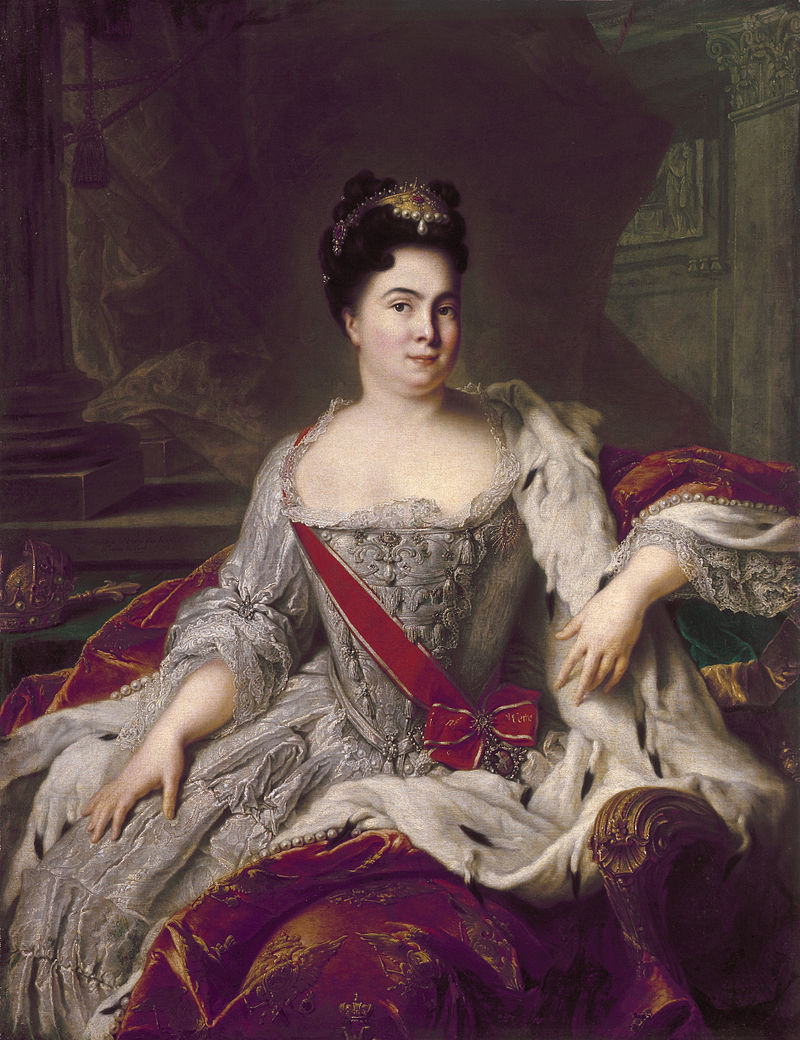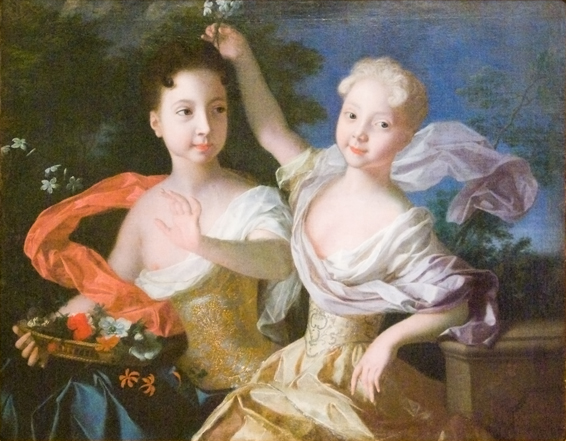by Susan Flantzer © Unofficial Royalty 2018

Catherine I, Empress of All Russia; Credit – Wikipedia
Catherine I, Empress of All Russia was the second wife of Peter I (the Great), Emperor of All Russia. She succeeded her husband upon the Russian throne, a very unexpected occurrence considering her meager beginnings. Her early background is very sketchy. Marta Helena Skowrońska is said to have been born on April 15, 1684, in Jakobstadt, Semigallia, Duchy of Courland and Semigallia. Today, Jakobstadt is known as Jēkabpils, and it is in Latvia. At the time of Catherine’s birth, the Duchy of Courland and Semigallia was a vassal state of the Polish-Lithuanian Commonwealth. Her parents were Samuel Skowroński, an ethnic Polish Roman Catholic peasant, and Dorothea Hahn, who both died of the plague around 1689, leaving their five children orphans.
Catherine had four siblings. When she became Empress of All Russia in 1725, she brought them to St. Petersburg, Russia, and created them Count/Countess:
- Krystyna Skowrońska (1687 – 1729), renamed Christina Samuilovna Skavronskaya, married Simon Heinrich <surname unknown>, their descendants became the Counts Gendrikov
- Anna Skowrońska, renamed Anna Samuilovna Skavronskaya, Michael-Joachim <surname unknown>, their descendants became the Counts Efimovsky
- Karol Skowroński, renamed Karel Samuilovich Skavronsky, married a Russian woman, Maria Ivanovna <surname unknown>, created Count of the Russian Empire, male line died out in 1793
- Fryderyk Skowroński, renamed Feodor Samuilovich Skavronsky, married (1) an unknown Lithuanian woman (2) Ekaterina Rodionovna Saburova, created Count of the Russian Empire, no children from either marriage
When Marta was five years old, her uncle sent her to live in the household of Johann Ernst Glück, a Lutheran pastor, the first to translate the Bible into Latvian. Marta served as a maid, was not taught to read, and remained illiterate for her entire life. At the age of 17, Marta was married to a Swedish dragoon named Johann Raabe during the Great Northern War. A few days after the wedding, Marta’s husband left with his regiment, which departed for the war and was never heard of again.

Peter I (the Great), Emperor of All Russia; Credit – Wikipedia
After the Russian army invaded her town, Marta was either a maid or the mistress of the Russian general, and she traveled back to the Russian court with the army. She became part of the household of Prince Alexander Menshikov, the best friend of Peter I (the Great), Emperor of All Russia. Peter met Marta while visiting Menshikov. By 1704, Marta was well established in Peter’s household as his mistress and had given birth to a son. In 1705, she converted to Russian Orthodoxy from Roman Catholicism and took the name of Catherine (Ekaterina) Alexeievna. Although no official record exists, Peter and Catherine secretly married between October 23 and December 1, 1707, in St. Petersburg. They married publicly on February 19, 1712, at Saint Isaac’s Cathedral in St. Petersburg. Their daughters, Anna and Elizabeth, were the bridal attendants.

Catherine and Peter’s daughters, Anna and Elizabeth; Credit – Wikipedia
Catherine and Peter had twelve children, all of whom died in childhood except Anna and Elizabeth:
- Pyotr Petrovich, born 1704, died in infancy
- Pavel Petrovic,h born 1705, died in infancy
- Catherine Petrovna (1706 – 1708)
- Grand Duchess Anna Petrovna (1708 – 1728), married Karl Friedrich, Duke of Holstein-Gottorp, had one son, Carl Peter Ulrich, the future Peter III, Emperor of All Russia, Anna died of childbirth complications
- Elizabeth, Empress of All Russia (1709 – 1762), unmarried
- Maria Petrovna of Russia (1713–1715)
- Margarita Petrovna (1714 – 1715)
- Pyotr Petrovich (1715 – 1719)
- Pavel Petrovich (born and died 1717)
- Grand Duchess Natalia Petrovna (1718 – 1725), died from measles a month after her father’s death
- Pyotr Petrovich (born and died 1723)
- Pavel Petrovich (born and died 1724)

The cabin where Peter and Catherine lived while St. Petersburg was being built; Photo Credit – © Susan Flantzer
In 1703, Peter started building the new city of St. Petersburg. While the city was being built, he lived in a three-room log cabin with Catherine, where she did the cooking and cared for the children, and he tended a garden, as though they were an ordinary couple. The relationship was the most successful of Peter’s life, and many letters exist demonstrating the strong affection between Catherine and Peter. Catherine was very energetic, compassionate, charming, and always cheerful. She was the only one able to calm Peter in his frequent rages.
Previously titled Tsar of All Russia, Peter was officially proclaimed Emperor of All Russia on October 22, 1721. In 1724, all of Peter’s sons were dead, and the only other surviving male Romanov besides Peter was his young grandson Peter Alexeievich, the future Peter II, Emperor of All Russia. In 1722, Peter issued a decree stating that the reigning emperor should appoint a successor during his lifetime and that anyone may be named as heir. Perhaps he had Catherine in mind as his successor when he had her crowned as Empress and named co-ruler on May 18, 1724, at the Assumption Cathedral in the Moscow Kremlin. Even though Catherine had the title of Empress, Peter remained Russia’s actual ruler.
On February 8, 1725, Peter I (the Great), Emperor of All Russia, died at the age of 52 from a bladder infection without naming a successor. Catherine never left Peter’s bedside during his final illness, and he died in her arms. A coup arranged by Peter’s best friend, Prince Alexander Menshikov, proclaimed Catherine the ruler of Russia. During the two-year reign of Catherine I, Empress of All Russia, the real power was held by Menshikov and members of the Supreme Privy Council.
During her short reign, Catherine was happy to leave the job of governing to her advisers. She was interested only in issues regarding the navy because Peter’s love for the sea had also touched her. Catherine spent much time at Tsarskoye Selo (Tsar’s Village), 15 miles/24 kilometers outside St. Petersburg. The estate had originally belonged to a Swedish noble. Peter gave it to Catherine in 1708, and Catherine started to develop Tsarskoye Selo as a royal country residence. In 1717, Catherine hired German architect Johann-Friedrich Braunstein to construct a summer palace named after her, the Catherine Palace. Her daughter Elizabeth, Empress of All Russia, later remodeled the palace into the one we see today.
Catherine’s health was adversely affected by living a difficult life, giving birth to twelve children, having a venereal disease that she contracted from Peter, and her heavy drinking after Peter’s death. On May 17, 1727, 43-year-old Catherine I, Empress of All Russia, died of tuberculosis at the Catherine Palace at Tsarskoye Selo. She was buried in a tomb next to her husband’s tomb at the Peter and Paul Cathedral in St. Petersburg. Later, their daughter, Elizabeth, Empress of All Russia, was buried next to Catherine.

Peter and Paul Cathedral – Row 1 left to right: Tombs of Elizabeth I, Catherine I, Peter I; Row 2 left to right: Tombs of Catherine II, Peter III, Anna I; Photo Credit – © Susan Flantzer
This article is the intellectual property of Unofficial Royalty and is NOT TO BE COPIED, EDITED, OR POSTED IN ANY FORM ON ANOTHER WEBSITE under any circumstances. It is permissible to use a link that directs to Unofficial Royalty.
Romanov Resources at Unofficial Royalty
- Tsardom of Russia/Russian Empire Index
- Romanov Births, Marriages and Deaths
- Romanov Burial Sites
- Romanovs Killed During the Russian Revolution
- Romanovs Who Survived the Russian Revolution
Works Cited
- En.wikipedia.org. (2017). Catherine I of Russia. [online] Available at: https://en.wikipedia.org/wiki/Catherine_I_of_Russia [Accessed 23 Dec. 2017].
- Lincoln, W. Bruce. (1981). The Romanovs: Autocrats of All the Russias. New York, NY.: Doubleday
- Massie, Robert K. (1980). Peter The Great: His Life and World. New York, NY.: Alfred A. Knopf
- Ru.wikipedia.org. (2017). Екатерина I. [online] Available at: https://ru.wikipedia.org/wiki/%D0%95%D0%BA%D0%B0%D1%82%D0%B5%D1%80%D0%B8%D0%BD%D0%B0_I [Accessed 23 Dec. 2017].

